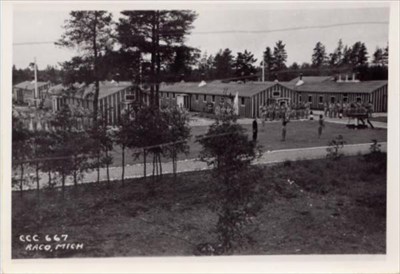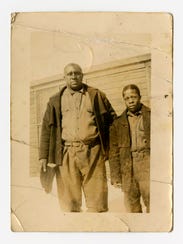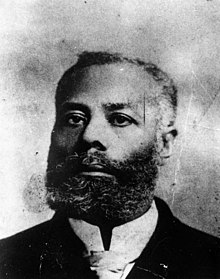Elijah McCoy was born on May 2, 1844 in Canadato fugitive slaves who moved to Ypsilanti when Elijah was three. He studied, apprenticed, and became a mechanical engineer in Scotland, but when he returned to Michigan, because he was black, he could only work as a fireman and oiler on the railroad. He had a machine shop at his home, and he invented an oil cup lubricating system for steam engines. Though it was often copied, his system was preferred, hence engineers asking for “the real McCoy.”
After the turn of the century, he attracted notice among his black contemporaries. Booker T. Washington in Story of the Negro (1909) recognized him as having produced more patents than any other black inventor up to that time. This creativity gave McCoy an honored status in the black community that has persisted to this day. He continued to invent until late in life He went on to patent nearly 60 inventions, most for lubricating systems, but he also invented a portable ironing board, a lawn sprinkler, and type of tire tread.
Elijah McCoy died in the Eloise Infirmary in Nankin Township, now Westland, Michigan, on October 10, 1929, at the age of 85, after suffering injuries from a car accident seven years earlier in which his wife Mary died. He is buried in Detroit Memorial Park East in Warren, Michigan

Elijah McCoy Historical Marker in Ypsilanti.
After his death, numerous historical markers were erected in Michigan, including at his various homes, his first workshop, and his grave, and :
- in 2001, McCoy was inducted into the National Inventors Hall of Fame in Akron, Ohio.
- in 2012, the Elijah J. McCoy Midwest Regional U.S. Patent and Trademark Office (the first USPTO satellite office) was opened in Detroit, Michigan.
Sources:
On May 2, 1907, Detroit Recorders Court Judge James Thelan made news when he told the mothers of two 16-year-old girls that if they could not “keep your children from going to places where they shouldn’t go, you might better cut off their legs.”
“It would be far better for them to be virtuous cripples than the certain kind of woman they are likely to become if they continue in the way they have been going.”
The two girls were chastised for frequenting east side dance halls. After Thelan’s lecture, one mother fainted, both girls wept “violently,” and the two girls were sentenced to five years at the Industrial Home for Girls at Adrian.
Source: “Advised to Cut off Legs of Thier Girls: Mothers of Juvenile Disorderlies Told by Judge Phelan It’s Better to be Virtuous Cripple Than Certain Kind of Woman”, Detroit Free Press, May 3, 1907, p.2

On this day, two hundred young men from Detroit arrive at an isolated spot in Chippewa County near Sault Ste. Marie and set up Camp Raco — Michigan’s first Civilian Conservation Corps (CCC) facility. Within months, dozens of similar camps opened across northern Michigan. One of President Franklin D. Roosevelt’s most popular New Deal relief programs, the CCC was a massive conservation program that employed tens of thousands of young men all across the nation. The CCC revitalized Michigan’s state park system, established Isle Royale National Park and built campgrounds in Michigan’s national forests. All benefited the state as tourism became one of its main economic resources. Michigan enrollees also sent home $20 million of their monthly salaries and acquired invaluable training that made their transition to military service in World War II easier. When the program ended in 1942, more than 100,000 Michigan men had served in the CCC. Their accomplishments included: planting more than 484 million seedlings (more than twice the number in any other state), expending 140,000 man-days in fighting forest fires, placing 150 million fish in rivers and lakes, and constructing 7,000 miles of truck trails, 504 buildings and 222 bridges.
After the CCC camp closed, the facilities were used during World War II as a German prisoner of war camp. The camp held approximately 267 German POWs.
Sources :
Roger L. Rosentreter, “Roosevelt’s Tree Army: Michigan’s Civilian Conservation Corps” courtesy of the ichigan Department of Natural Resources. “Roosevelt’s Tree Army” originally appeared in the May/June 1986 issue of Michigan History Magazine and was reprinted as one of a series of “Michigan Time Capsules” in 1986. It is now out-of-print.
Also see Patricia Zacharias, “The Civilian Conservation Corps”, Detroit News, January 22, 1997.
GEO 333 : Geography of Michigan and the Great Lakes Region at Michigan State University by Dr. Randall J. Schaetzl instructor.
For a novel set at Camp Raco, see Big shoulders / William Jamerson. Escanaba, Mich. : Pine Stump Publishing, c2007. Jamerson’s novel follows a year in the life of a seventeen-year-old youth from Detroit who enlists in the CCC in 1937. The enrollee joins two hundred other young men at Camp Raco, a work camp in Michigan’s Upper Peninsula run by army officers. It is a coming-of-age story of an angry teenager who faces the rigors of hard work, learning to get along with a difficult sergeant and coping with a bully.
Also see Jeff Karoub, “Rare photos reveal, recognize Michigan black work camps during Depression“, Detroit Free Press, April 7, 2018. The Bentley Historical Library owns pictures of black Civilian Conservation Corps camps in Michigan and elsewhere during the Great Depression. The photos are the only known images of the state’s segregated, all-black camps. CCC camps initially were integrated, according to the university, but became segregated by 1935 amid community protests. Out of Michigan’s roughly 150 camps, some 16 were designated for black men. Black membership was capped at 10 percent of the overall corps, which numbered around 3 million over the course of the program.

In a photo provided by the Bentley Historical Library, James “Big Jim” Richardson, left, is photographed at Free Soil Camp in 1936 in Michigan. (Photo: Bentley Historical Library via Associated Press). The Michigan History Center says the state’s black camps helped build a ski area and contributed to efforts to plant millions of trees, fight forest fires, construct bridges and buildings, and establish public campgrounds.

On May 2, 1939, Lou Gehrig of the New York Yankees, the “iron man” of baseball, removed himself from the lineup prior to the first pitch at Briggs Stadium (later Tiger Stadium) after 2,130 consecutive games. Later, it was determined that Gehrig had amyotrophic lateral sclerosis (ALS), an incurable degenerative disease of the nervous system now known to many as “Lou Gehrig’s Disease.
Source : Detroit Historical Society Facebook page
On May 2, 1964, plans for a “Great Society” are announced.
President Lyndon B. Johnson, speaking at spring commencement at the University of Michigan in Ann Arbor, announced his plans for building a “Great Society,” a domestic plan including Medicare, Medicaid, the Civil Rights Act of 1964, and the Voting Rights Act of 1965. Originally scheduled to last just ten minutes, Johnson’s speech lasted twenty minutes due to fourteen interruptions for applause by the audience. An estimated 85,000 people were in attendance for commencement, which was held at Michigan Stadium. Johnson’s Presidential Papers later revealed that the Ann Arbor commencement address was designed to set the tone for the 1964 election and the administration’s entire domestic policy agenda.
For more information about President Johnson’s Ann Arbor commencement speech, see The Anatomy of a Speech: Lyndon Johnson’s Great Society Address by Robert M. Warner.
Source : Michigan Historical Calendar, courtesy of the Clarke Historical Library at Central Michigan University.

Planning a band formation at Michigan State College. Image from the Michigan State University Archives an Historical Collection.
Leonard V. Falcone (5 April 1899 – May 2, 1985) was best known for being Professor of Baritone Horn and Euphonium at Michigan State University, where he also served from 1927 to 1967 as Director of Bands. The school’s Spartan Marching Band transitioned from an ROTC auxiliary to a nationally known Big Ten Conference marching band during his tenure. He was a well known performer, lecturer, arranger and conductor. Scholarship endowments at Michigan State University and Blue Lake Fine Arts Camp as well as the Falcone International Tuba and Euphonium Festival were established in his honor.
Leonard followed his brother’s example at the University of Michigan by integrating the band. During World War II, Leonard filled out his band ranks by inviting women to join the concert band for the first time. They never left even after the war ended. Leonard also contributed to the heritage of the MSU marching band by creating the longer arrangement for Victory for MSU. Known as the “Falcone Fight,” you will still hear it played at MSU athletic events and parades.
Oddly enough, Leonard Falcone was the only Band Director to serve simultaneously at both Michigan State University and the University of Michigan. For the rest of the story see James Tobin, “Brothers of Band“, Michigan Today, October 17, 2016.

The Brothers Falcone in East Lansing. Image from the Michigan State University Archives an Historical Collection.
Sources:
Leonard Falcone wikipedia entry
James Tobin, “Brothers of Band“, Michigan Today, October 17, 2016.
Tradition, fraternity and the Falcone Brothers, courtesy of the Interlochen Center for the Arts
On May 2, 2005, the Pontiac Grand Am ceased production at the 100-year-old Lansing Car Assembly plant.
Courtesy of WAKV (Plainwell, MI), The Memory Station
Pontiac Grand Am Timeline (1973-2005) courtesy of YouTube.
A magnitude 4.2 earthquake shook Michigan on Saturday afternoon and residents in Metro Detroit reported feeling the earth move.
The earthquake was centered 8km south of Galesburg, outside of Kalamazoo and was recorded shortly after noon, said National Weather Service White Lake meteorologist Joseph Clark.
Larry Ruff, a seismologist in the University of Michigan’s Department of Earth and Environmental Sciences, said Saturday’s today’s quake was the largest quake with an epicenter in Michigan since a magnitude-4.6 earthquake near the town of Coldwater on Aug. 10, 1947.
The Coldwater quake was the largest Michigan earthquake in records dating back about a century. The last significant earthquake in Michigan was a magnitude-3.5 event that occurred on Sept. 2, 1994, southwest of Lansing.
“We feel a lot of relatively small earthquakes in the state, but most of them occur to the south of Michigan,” Ruff said. “So to have an earthquake of this magnitude with the epicenter in Michigan is very unusual.”
The distance between the 1947 Coldwater earthquake and Saturday’s quake near Galesburg is less than 50 miles, and Ruff said he will try to determine if they are related. “I think it could be significant that they are so close, but we just don’t know yet.”
People reported feeling tremors in Indiana, Ohio, Illinois and across Lake Michigan in Wisconsin.
For the full article, see “A 4.2 earthquake rattles Michigan”, Detroit News, May 2, 2015.
For another, see Jennifer Dixon and Gina Damron, “No injuries reported after earthquake rattles Michigan”, Detroit Free Press, May 2, 2015.
A Cub Scout troop in Dearborn is celebrating its first female members just as the Boy Scouts of America announced it is dropping the word “boys” from its title.
Cub Scout Pack No. 112 inducted nine girls as members at a ceremony Tuesday at the First United Methodist Church on Garrison Street.
The pack is one of only a handful in the country that featured “cub cadets.” The program allows a scout’s younger siblings, including girls, to participate in activities minus official recognition by the Boy Scouts of America or advancements.
The Boy Scouts of America board of directors announced in October that the group would admit girls, creating the Family Scouting program. Pack 1112 became an “early adopter” because of its cub cadet program. Other packs across the country are opening the program to girls starting in June.
The Cub Scouts program for younger children was the first to open up to girls. Thousands of girls have already joined under an early adopter program.
Other Boy Scouts programs for older youth — such as an outdoor adventure program called Venturing — were already open to girls. But those programs didn’t offer girls the chance to attain the highest rank of Eagle Scout.
By next year, older girls will be able to join Scouts BSA and try to become Eagle Scouts, just like the boys.
Source: Aleanna Siacon, “Dearborn pack gets its first female Cub Scouts as group welcomes girls“, Detroit Free Press, May 2, 2018.
On May 3, 1881, Leonidas G. Woolley, of Mendon, patented the nation’s first electric locomotive headlight. Woolley suspended his polygonal lamp frame in position with opposing strings which neutralized jarring.
Source: Mich-Again’s Day.

